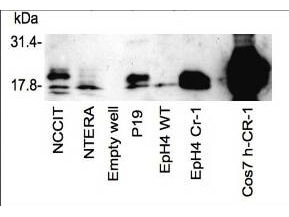Anti-Cripto-1 (TDGF1) (RABBIT) Antibody
Cripto-1 TDGF1 Antibody
- SPECIFICATION
- CITATIONS
- PROTOCOLS
- BACKGROUND

| Host | Rabbit |
|---|---|
| Conjugate | Unconjugated |
| Target Species | Human |
| Reactivity | Human, Mouse |
| Clonality | Polyclonal |
Application
| WB, IHC, E, I, LCI |
| Application Note | This affinity purified antibody has been tested for use in ELISA and western blotting. Specific conditions for reactivity should be optimized by the end user. Expect a band approximately 21 kDa in size corresponding to Cripto-1 by western blotting in the appropriate cell lysate or extract. Cripto-1 is reported as a 188 amino acid protein with a molecular weight of 21.1 kDa. |
| Physical State | Liquid (sterile filtered) |
| Buffer | 0.02 M Potassium Phosphate, 0.15 M Sodium Chloride, pH 7.2 |
| Immunogen | This affinity purified antibody was prepared from whole rabbit serum produced by repeated immunizations with a synthetic peptide corresponding to an internal sequence of human Cripto-1 protein. |
| Preservative | 0.01% (w/v) Sodium Azide |
| Gene ID | 6997 |
|---|---|
| Other Names | 6997 |
| Purity | This product was affinity purified from monospecific antiserum by immunoaffinity chromatography. This antibody is specific for human Cripto-1 protein. A BLAST analysis was used to suggest limited cross-reactivity with Cripto-1 from mouse based on a 70% homology with the immunizing sequence. Expect cross-reactivity with human Cripto-3 (TDGF2) based on very high levels of sequence conservation. Cross-reactivity with Cripto-1 from other sources has not been determined. |
| Storage Condition | Store vial at -20° C prior to opening. Aliquot contents and freeze at -20° C or below for extended storage. Avoid cycles of freezing and thawing. Centrifuge product if not completely clear after standing at room temperature. This product is stable for several weeks at 4° C as an undiluted liquid. Dilute only prior to immediate use. |
| Precautions Note | This product is for research use only and is not intended for therapeutic or diagnostic applications. |
| Name | CRIPTO {ECO:0000303|PubMed:2792079, ECO:0000312|HGNC:HGNC:11701} |
|---|---|
| Function | GPI-anchored cell membrane protein involved in Nodal signaling. Cell-associated CRIPTO acts as a Nodal coreceptor in cis. Shedding of CRIPTO by TMEM8A modulates Nodal signaling by allowing soluble CRIPTO to act as a Nodal coreceptor on other cells (PubMed:27881714). Could play a role in the determination of the epiblastic cells that subsequently give rise to the mesoderm (PubMed:11909953). |
| Cellular Location | Cell membrane; Lipid-anchor, GPI-anchor. Secreted. Note=Released from the cell membrane by GPI cleavage. |
| Tissue Location | Preferentially expressed in gastric and colorectal carcinomas than in their normal counterparts. Expressed in breast and lung. |

Thousands of laboratories across the world have published research that depended on the performance of antibodies from Abcepta to advance their research. Check out links to articles that cite our products in major peer-reviewed journals, organized by research category.
info@abcepta.com, and receive a free "I Love Antibodies" mug.
Provided below are standard protocols that you may find useful for product applications.
Background
This antibody is designed, produced, and validated as part of a collaboration between Rockland and the National Cancer Institute (NCI) and is suitable for Cancer, Immunology and Nuclear Signaling research. Human Cripto-1 (CR-1), also known as Teratocarcinoma-derived growth factor 1 (TDGF1), is a member of the epidermal growth factor (EGF)-GFC family and has been implicated in both embryogenesis and carcinogenesis. During early vertebrate development, CR-1 functions as a co-receptor for Nodal, a transforming growth factor b (TGFb) family member, and is essential for mesoderm and endoderm formation and anterior-posterior and left-right axis establishment. In adult tissues, CR-1 is expressed at a low level in all stages of mammary gland development, and expression increases during pregnancy and lactation. Over-expression of CR-1 in mouse mammary epithelial cells leads to their transformation in vitro, and when injected in mammary glands, CR-1 produces ductal hyperplasias.
If you have used an Abcepta product and would like to share how it has performed, please click on the "Submit Review" button and provide the requested information. Our staff will examine and post your review and contact you if needed.
If you have any additional inquiries please email technical services at tech@abcepta.com.













 Foundational characteristics of cancer include proliferation, angiogenesis, migration, evasion of apoptosis, and cellular immortality. Find key markers for these cellular processes and antibodies to detect them.
Foundational characteristics of cancer include proliferation, angiogenesis, migration, evasion of apoptosis, and cellular immortality. Find key markers for these cellular processes and antibodies to detect them. The SUMOplot™ Analysis Program predicts and scores sumoylation sites in your protein. SUMOylation is a post-translational modification involved in various cellular processes, such as nuclear-cytosolic transport, transcriptional regulation, apoptosis, protein stability, response to stress, and progression through the cell cycle.
The SUMOplot™ Analysis Program predicts and scores sumoylation sites in your protein. SUMOylation is a post-translational modification involved in various cellular processes, such as nuclear-cytosolic transport, transcriptional regulation, apoptosis, protein stability, response to stress, and progression through the cell cycle. The Autophagy Receptor Motif Plotter predicts and scores autophagy receptor binding sites in your protein. Identifying proteins connected to this pathway is critical to understanding the role of autophagy in physiological as well as pathological processes such as development, differentiation, neurodegenerative diseases, stress, infection, and cancer.
The Autophagy Receptor Motif Plotter predicts and scores autophagy receptor binding sites in your protein. Identifying proteins connected to this pathway is critical to understanding the role of autophagy in physiological as well as pathological processes such as development, differentiation, neurodegenerative diseases, stress, infection, and cancer.


